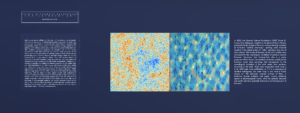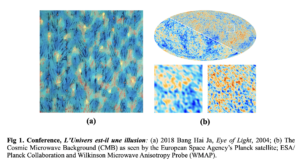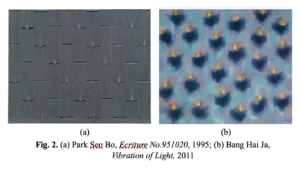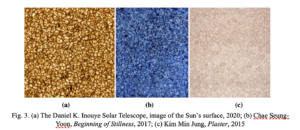Curated by Dami Lee
The interdisciplinary curatorial research investigates elements of void, spirituality, and light in contemporary art along with recent theoretical developments in cosmology and astrophysics to portray fundamental humanitarian values. Drawing from various theoretical and philosophical bases including, linguistics, neuroanatomy, and philosophy, the curatorial research presents a metaphysical interpretation of light, demonstrating the permeability and intersection between science and art. The research documents numerous contemporary artworks associated with the dimensions of space and time, which represent a lingua franca of modern art that serves as a cultural seismograph of the integrated and interdependent global art scene.
VIRTUAL EXHIBITION
https://www.oarbt.com/exhibition/published/1a8fd01073?Contemporary-Art-Theory
- Dates/ Duration: Enabling ubiquitous access to the digital curatorial project without limitations to location and time restrictions.


EXHIBITION CONTENT
In modern cosmological paradigms, the fundamental spatial organization of matter and galaxies are composed of immaterial dark matter filament structures (FS) representing around ninety percent of the observed energy content of the universe, while ordinary matter accounts for only five percent of the universe. This ubiquitous structure comprises an essential part of the current cosmological model that dominates the evolution and emergence of the cosmos, and the most prominent and defining properties of the cosmic web are present throughout quantum vacuums and dark energy which can only be detected from its gravitational effects. Thus, the modern theory of cosmological structure formation is entering a new era, and cosmologists and astrophysicists have conducted theoretical and experimental investigations in attempts to quantify and catalog the internal properties of dark matter halos and void populations in the local universe with respect to the visible matter (i.e., stars, gas clouds, and cosmic dust). Numerous scientists believe that the profuse number of esoteric substances lies beyond the current theoretical edifice of particle physics.
The advent of large galaxy surveys and computational analysis of primordial nucleosynthesis has brought the standard cosmological model a step closer toward gaining deeper insights into the emergence of spatial complexity of the vast ocean of dark matter, yet we are only at the beginning of systematically exploring the various structural aspects of the cosmic web. While these types of scalar particles are elusive to be observed in particle experiments, astrophysicists have identified that light plays a crucial role in the formation of galaxies and galaxy clusters. In 2009, David Elbaz, a research director at the Commissariat à l’Energie Atomique et aux Énergies Alternatives (CEA Saclay), who is at the forefront of discovering new connections between particle physics and astronomy, presented his research at the Sorbonne University Pierre and Marie Curie (UPMC) with artist Bang Hai Ja’s artwork (Fig. 1). The image on the right shows variations in the first map of the Cosmic Microwave Background (CMB) as observed by the European Space Agency’s Planck satellite, which was reproduced in greater resolution by the NASA’s Wilkinson Microwave Anisotropy Probe (WMAP) based on data collected over nine years, and the image on the left displays the artwork titled, Eye of Light (2004). Elbaz expressed the profound correlation between cosmology and the artwork as follows:

Furthermore, numerous international artists such as, Richard Pousette-Dart, Kim Tschang-yeul, and Jung Sang Wha, among many others, contemporaneously produced cosmological images of void or immaterial substances radiating in austere sublimity. For example, Ecriture No.951020 (1995), by Park Seo Bo, compositionally correlates with, Vibration of Light (2011), by Bang Hai Ja. A notable figure of the Korean Dansaekhwa movement, artist Park eliminates all desires in prolonged meditation, while the spiritual, temporal and spatial elements gradually interweave and become part of his works “to create pure emptiness” or “space from the point of view of nature.” In the oriental philosophy, the concept of nature refers to the interdependent patterns between the cosmos and its microcosmic parts. The gray monochromatic surfaces represent a flow in which the all of its constituents belong to a single organismic process, since it contains multiple shades of light as white light produces a plethora of colors when seen through prisms. Artist Park explained, “color is not based on some method or ideology; it is an approach to nature, which includes everything in the universe: even what is invisible to us,” and “the same is true when I use white.”

The profound intersection and permeability between science and art is further demonstrated in recent discoveries at the National Science Foundation’s (NSF) Daniel K. Inouye Solar Telescope, situated on the island of Maui, Hawaii, which produced the first image of the sun’s surface displaying a pattern of turbulent “cell-like structures,” emitting solar material or plasma. The structural features of the sun’s cellular masses correspond to the artwork, Dance of Light (2016), by Bang Hai Ja, as well as the cosmological simulation of the density field of CMB and its halo population, which further provides evidence of the cosmic web which is a key component (i.e., “scaffold”) of the universe in which galaxies form.
These cosmological images are echoed in the artworks above, Beginning of Stillness (2017) and Plaster (2015), from the “Void in Fullness” series. The transparently overlapped particles become further magnified in, Space-less (2015), and artist In Kyum Kim explained, “My work is an ontological inquiry into the object’s soul,” and the delicately applied paint represents a “transcendental space that crosses the boundaries between planes, dimensions, substances and illusions…. It is a place of silence that guarantees the path of the unknown, leading to the space of birth at the beginning.” Similarly, a Scottish abstract painter, Callum Innes, exposed the fragility of nature in remnants of light by removing layers of saturated oil paint in repetitive gestures resulting in a “luminous” reductionist aesthetic.
